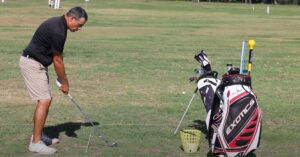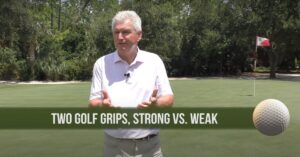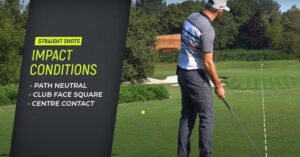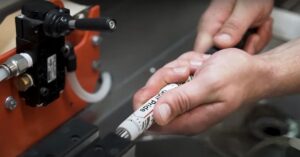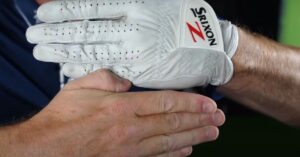What Starts The Backswing In Golf? Mastering The Backswing
When it comes to the game of golf, the backswing is a crucial part of a golfer’s technique. It sets the stage for a powerful and accurate shot. But have you ever wondered what initiates the backswing?
The answer lies in the golfer’s hands and wrists. With a solid grip on the club and proper wrist hinge, the golfer begins the backswing, generating the momentum needed for a successful shot. The hands and wrists act as catalysts, leading the way for a fluid and controlled swing.
In this blog post, we will delve deeper into the mechanics of the backswing and explore how mastering this fundamental movement can significantly improve your golf game.
Key Elements Of A Successful Backswing

The backswing is a crucial component of a golfer’s technique, setting the stage for a powerful and accurate shot. To achieve success, several key elements must come together seamlessly.
Here is a list of key elements of a successful backswing in golf
Grip
The grip is the golfer’s connection to the club and plays a vital role in the backswing. A proper grip ensures control and stability throughout the swing.
The hands should form a unified grip with the club, neither too tight nor too loose. Maintaining a neutral grip allows for better clubface control during the backswing.
Posture
Maintaining proper posture sets the stage for an effective backswing. The golfer should stand tall with a slight flex in the knees and a straight back.
The weight should be evenly distributed between the feet, promoting balance and stability throughout the swing. A solid posture enables a smooth and coordinated backswing motion.
Rotation
Efficient rotation of the body is crucial in generating power and creating a consistent backswing. The shoulders, hips, and torso should rotate in unison, allowing for a full shoulder turn.
The backswing should be controlled and smooth, avoiding excessive lateral or vertical movements. Proper rotation sets the stage for an explosive downswing and optimal clubhead speed.
Balance
Maintaining balance throughout the backswing is essential for consistent ball striking. The weight should shift slightly to the trail foot during the takeaway and backswing, creating a stable foundation.
Strive for a balanced weight distribution between the feet at the top of the backswing, avoiding excessive leaning or swaying.
Solid balance ensures control and precision during the swing.
Tempo
A smooth and controlled tempo is key to a successful backswing. Rushing the backswing can lead to a loss of synchronization and poor shot execution. Take time to establish a consistent rhythm, allowing for a gradual buildup of power. A balanced and measured tempo promotes a synchronized swing and enhances overall shot quality.
Common Backswing Mistakes To Avoid

Regarding golf, the backswing is a crucial component of a successful swing. However, many golfers make common mistakes that can hinder their performance.
Here are some common backswing mistakes should avoid
Lack of Proper Rotation
One common mistake in the backswing is failing to achieve proper rotation. Golfers often rely too much on their arms and neglect the rotational movement of their torso.
This can lead to limited power and inconsistency in the swing. To avoid this, focus on rotating your upper body and engaging your core muscles during the backswing.
Overactive Hands
Another mistake is using excessive hand and wrist movement during the backswing. This can result in a loss of control and accuracy.
Instead, strive for a smooth and controlled backswing, keeping your hands and wrists passive while allowing your body to generate power.
Incorrect Club Position
Improper club positioning during the backswing can cause a variety of issues. One common error is taking the club too far inside or outside the correct swing plane.
This can lead to an inconsistent swing path and poor ball contact. To avoid this, practice maintaining the club on the correct swing plane throughout the backswing, which is typically slightly above the target line.
Lack of Tempo and Rhythm
Maintaining a consistent tempo and rhythm is essential in a successful backswing. Rushing or decelerating during the swing can disrupt the timing and fluidity of your motion.
Focus on developing a smooth and balanced backswing, allowing for a seamless transition into the downswing.
Limited Shoulder Turn
A restricted shoulder turn is a common mistake that can limit your power and distance. To maximize your swing potential, aim for a full shoulder turn during the backswing.
This will allow you to generate more torque and increase clubhead speed, resulting in longer and more accurate shots.
Swaying or Sliding
Excessive lateral movement, such as swaying or sliding, can negatively impact your backswing. It can cause loss of balance, poor weight transfer, and inconsistent ball striking.
Focus on maintaining a stable lower body and rotating around your spine, minimizing any unnecessary lateral motion.
Ignoring Alignment and Posture
Proper alignment and posture are fundamental in the backswing. Failing to address these aspects can lead to various swing faults.
Ensure that your feet, hips, and shoulders are properly aligned to your target line, and maintain a balanced and athletic posture throughout the backswing.
Tips For Initiating A Powerful Backswing

The backswing is a crucial part of a powerful golf swing. It sets the foundation for a strong and accurate shot. To initiate a powerful backswing, follow these steps.
Proper Setup
Begin with a balanced stance, feet shoulder-width apart and knees slightly flexed. Align your body parallel to the target line and grip the club with a neutral hand position.
Rotation of the Hips
Initiate the backswing by rotating your hips away from the target. This rotation creates torque and helps store energy for the downswing.
Shoulder Turn
As your hips rotate, allow your shoulders to turn naturally and smoothly. Aim for a 90-degree shoulder turn while keeping your head steady.
Maintain a Connected Arm-Body Relationship
Keep your arms and body connected throughout the backswing. Avoid excessive tension or separation between your arms and body, as this can limit power.
Wrist Hinge
As your club moves back, gradually hinge your wrists to create a 90-degree angle between your left arm and the clubshaft. This position maximizes power potential.
Weight Transfer
Shift your weight to your back foot while maintaining a stable lower body. This transfer of weight helps load the swing and creates momentum for the downswing.
Maintain a Relaxed Grip
Avoid gripping the club too tightly during the backswing. Maintain a firm yet relaxed grip, allowing for fluid movement and a smoother transition.
Stay Balanced
Throughout the backswing, maintain a balanced posture and weight distribution. This stability ensures control and sets the stage for a powerful downswing.
Tempo and Rhythm
Focus on maintaining a consistent tempo and rhythm during the backswing. Avoid rushing or jerky movements, as they can disrupt the fluidity of the swing.
Practice and Feedback
Regular practice and seeking feedback from a golf instructor or experienced player can help you refine your backswing technique and optimize your power and accuracy.
Backswing Variations For Different Golf Clubs
Different golf clubs require varying backswing variations to optimize performance and achieve desired results.
Here, we’ll explore various backswing techniques tailored for different clubs, helping golfers improve their game and maximize their potential.
Driver
The driver is the longest club in a golfer’s bag and is used for long-distance shots off the tee. To maximize distance and generate clubhead speed, the backswing for the driver should be wide and sweeping.
Focus on a smooth takeaway, gradually increasing the shoulder turn while maintaining a consistent tempo.
Irons
Irons are versatile clubs used for various shots, ranging from mid-range approaches to precise shots around the green. The backswing for irons should be more compact compared to the driver.
Start by hinging your wrists early in the backswing, allowing for a steeper descent and increased control at impact.
Wedges
Wedges are essential for delicate shots near the green, requiring finesse and precision. The backswing for wedges should be shorter and more controlled.
Limit the wrist hinge and focus on a smoother, abbreviated swing to maintain accuracy and achieve the desired distance and spin.
Hybrids
Hybrids are designed to combine the best features of both irons and woods, offering versatility and forgiveness. The backswing for hybrids can vary depending on the desired shot.
It’s generally recommended to adopt a slightly wider and more sweeping backswing than irons, emphasizing a smooth transition to ensure solid contact.
Fairway Woods
Fairway woods are used for long shots off the fairway or tee, and their backswing technique falls between that of irons and drivers. Aim for a wider backswing than irons but not as wide as the driver.
Maintain a smooth tempo while generating enough power to maximize distance without sacrificing control.
Putting
Putting requires a unique backswing technique, emphasizing control and accuracy on the greens. The backswing for putting should be shorter and more pendulum-like. Focus on a smooth, consistent stroke, with the length of the backswing matching the desired distance of the putt.
Frequently Asked Questions
The backswing in golf is a crucial part of the swing that sets the stage for a powerful and accurate shot. To help clarify this topic, here are some frequently asked questions (FAQs) about what starts the backswing in golf.
What Role Does The Hands Play In Starting The Backswing?
During the backswing, the hands play a pivotal role in initiating the movement. They work in tandem with the shoulders and arms to begin the takeaway, ensuring a smooth and coordinated motion.
Is Weight Transfer Important In Starting The Backswing?
Yes, weight transfer is vital in starting the backswing. Shifting the weight from the back foot to the front foot helps create the necessary momentum for a controlled and powerful swing.
How Does The Rotation Of The Hips Contribute To The Backswing?
The rotation of the hips is a key component of the backswing. As the golfer starts their swing, the hips turn to generate torque and create a coil effect, which enables the golfer to generate more power during the downswing.
Should The Shoulders Be Involved In Initiating The Backswing?
Absolutely. The shoulders are integral to starting the backswing. They play a significant role in turning the upper body and coiling against the lower body, providing stability and generating energy for an effective swing.
What Is The Importance Of Maintaining Balance While Starting The Backswing?
Maintaining balance is crucial when starting the backswing. It ensures proper weight distribution and stability throughout the swing, allowing the golfer to maintain control and execute the desired shot with accuracy and power.
Conclusion
The backswing is initiated by the golfer’s body rotation and arm movement. It sets the stage for a powerful and accurate shot.
Understanding the proper technique and sequence of movements is crucial for a successful swing. Mastering the backswing is key to improving your golf game.

